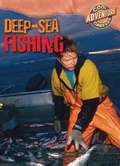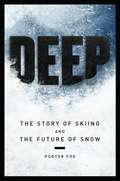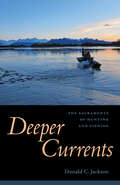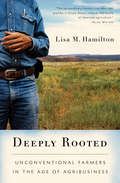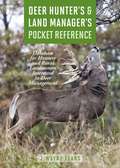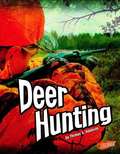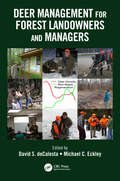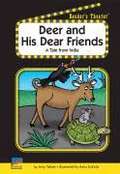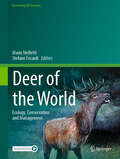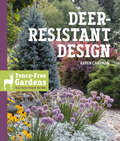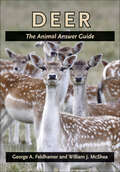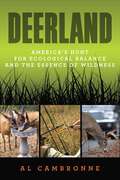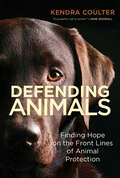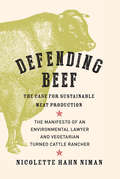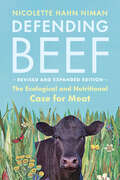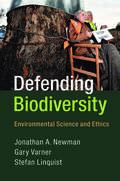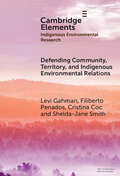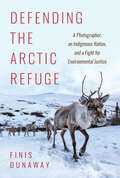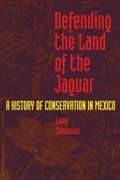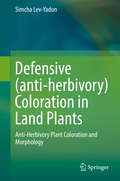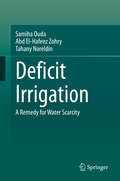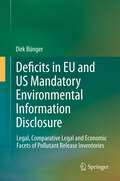- Table View
- List View
Deep-sea Fishing (Cool Adventure Careers)
by William David ThomasThe first group of titles in an ongoing series introduces students to six amazing adventure careers. Geared for reluctant readers in upper elementary school and above, each high-interest title combines easy-to-follow text with engaging on-the-job photos to spark students' interest in reading and career exploration. Each book is filled with descriptive information about the career, along with the skills and requirements needed to pursue a job in the profiled field.
Deep-sky Companions
by O’meara Stephen JamesIn this fresh list, Stephen James O'Meara presents 109 new objects for stargazers to observe. The Secret Deep list contains many exceptional objects, including a planetary nebula whose last thermal pulse produced a circumstellar shell similar to the one expected in the final days of our Sun's life; a piece of the only supernova remnant known visible to the unaided eye; the flattest galaxy known; the largest edge-on galaxy in the heavens; the brightest quasar; and the companion star to one of the first black hole candidates ever discovered. Each object is accompanied by beautiful photographs and sketches, original finder charts, visual histories and up-to-date astrophysical information to enrich the observing experience. Featuring galaxies, clusters and nebulae not covered in other Deep-Sky Companions books, this is a wonderful addition to the series and an essential guide for any deep-sky observer.
Deep: The Story of Skiing and the Future of Snow
by Porter FoxIn his stunning first book, veteran ski writer Porter Fox captures the 8,000-year-old sport of skiing, the miracle of snow and the shocking truth of how climate change could wipe out both in the next 75 years. The narrative follows the unlikely rise of skiing from prehistoric Norwegian hunters to nobility in the Alps in the 1800s to present-day freeriders on the vaunted slopes of the Rocky Mountains. On his global tour of the most celebrated mountains in the Northern Hemisphere from Washington's Cascade Range to the European Alps. Fox talks to alpinists about the allure and mysticism of the sport and to scientists about climate change and its effect on snow ultimately finding a story that is far larger than the demise of skiing.
Deeper Currents: The Sacraments of Hunting and Fishing
by Donald C. JacksonIn Deeper Currents, Donald C. Jackson guides us on a journey into the cathedrals of wild and lonely places, those sacred spaces where hunters and fishers connect with the rhythms of the earth and the spirit that resonates within us. Jackson explores hunting and fishing as frameworks—sacraments—for discovering, engaging, and finding meaning. He invites readers to consider connections with wilder realms of being. Hunting squirrels on an autumn morning, probing the woods, rifle in hand, Jackson reveals an attention to nature too often neglected. Following a bird dog into the damp and mysterious places where woodcock settle on their southbound migrations; chasing hounds on the trail of raccoons on a frosty winter night; stalking deer in a quiet corner of a small farm; fishing for carp in a creek, bass and bluegill in ponds, catfish in a murky river, and reef fish in the Gulf, Jackson reminds that we are stewards of not only resources but also a past that defines us as hunters and fishers. We must pass this legacy along to the generations that follow. In Deeper Currents, tractors and old barns find a place in the reader's heart. Boats and canoes navigate realms of danger and dreams. Jackson shares outdoor pilgrimages with good friends in cabins, tents, camps, and old trailers tucked beyond the reach of a rushing world. He rejoices in the whisper of stiff wings as ducks come to decoys, the call of geese and cranes over tidal flats, the hush before a storm, the muffled snap of a twig at twilight, a drop of dew falling on the surface of a pond, and the clicking of caribou hooves on an Alaskan gravel bar. Jackson finds these natural moments fill us with energy. They remind us that we are taking part in a sacred heritage and that creation is unfolding all around us.
Deeply Rooted: Unconventional Farmers in the Age of Agribusiness
by Lisa M. HamiltonA century of industrialization has left our food system riddled with problems, yet for solutions we look to nutritionists and government agencies, scientists and chefs. Lisa M. Hamilton asks: Why not look to the people who grow our food?Hamilton makes this vital inquiry through the stories of three unconventional farmers: an African-American dairyman in Texas who plays David to the Goliath of agribusiness corporations; a tenth-generation rancher in New Mexico struggling to restore agriculture as a pillar of his crumbling community; and a modern pioneer family in North Dakota who is breeding new varieties of plants to face the future's double threat: Monsanto and global warming. Threads of history and discussion weave through the tales, exploring how farmers have been pushed to the margins of agriculture and transformed from leaders to laborers.These unusual characters and their surprising stories make the case that in order to correct what has gone wrong with the food system, we must first bring farmers back to the table.
Deepwater Horizon
by James M. Blossom Earl BoebertIn 2010 BP's Deepwater Horizon catastrophe spiraled into the worst human-made economic and ecological disaster in Gulf Coast history. In the most comprehensive account to date, senior systems engineers Earl Boebert and James Blossom show how corporate and engineering decisions, each one individually innocuous, interacted to create the disaster.
Deer Hunter's & Land Manager's Pocket Reference: A Database for Hunters and Rural Landowners Interested in Deer Management
by J. Wayne FearsFinally, the deer hunting and land management reference you have always wanted! Get the answers to your deer hunting questions right now, in the field, with this pocket size, take-with-you, reference book. Use it to settle those campfire debates or to figure out a hunting technique for that elusive buck you have been tracking or to mix your own special food plot seed mix. For the first time, here is a unique reference book that is filled with a collection of useful information to help make you a more successful deer hunter and a better woodsman. It’s like having an expert in your pocket. This book includes Facts about the deer Food plot information Deer caliber ballistic tables Trophy scoring and score sheets Land measurements Butchering how-to Hunt lease management Survival and safety Field judging bucks And much, much more
Deer Hunting (Blazers Wild Outdoors)
by Thomas AdamsonA hunter fires a rifle at a huge buck. Will the hunter score a deer? Deer hunters know that a successful hunt takes skill, patience, and the right equipment. Get the inside information on the guns, ammunition, and safety skills you'll need to take down a trophy buck.
Deer Management for Forest Landowners and Managers
by David S. deCalesta and Michael C. EckleyThis book is designed to help landowners and forestry professionals develop, implement, and monitor programs to manage both deer and forests with emphasis on resolving deer impact issues. Chapters cover management strategies through identifying and setting goals; managing deer populations and deer impact on land; economics of forest, deer, and impact management; human dimensions of deer management; and developing and implementing integrated management plans. The book presents an integrated, quantitative approach for managing deer populations and impacts so users can manage forest resources sustainably.
Deer and His Dear Friends: A Tale from India
by Jeffrey Fuerst Anita Dufalla Amy TalbotPerform this tall tale from India about animals who save their deer friend from a hunter's trap.
Deer of the World: Ecology, Conservation and Management (Fascinating Life Sciences)
by Mario Melletti Stefano FocardiThis book is the first comprehensive reference work ever published on the systematics, ecology, conservation status, and management of all the world's deer species. Covering all 53 deer species worldwide, this volume brings together the contributions of 160 international deer experts and provides: A comprehensive overview of the current state of knowledge on the evolution, phylogeny, taxonomy, and systematics of deer An in-depth insight into the ecology and conservation status of each species, with detailed accounts A series of case studies on conservation, management, hunting, farming, disease ecology, and the impact of deer on forest ecosystems. This beautifully illustrated book is an invaluable resource for researchers, wildlife managers, and students of conservation biology, ecology, and management, as well as the interested layperson. It reveals the fascinating story of deer evolution, the long history of human interactions with deer, and the major threats to this charismatic species group.
Deer-Resistant Design: Fence-free Gardens that Thrive Despite the Deer
by Karen Chapman“Fear deer no more! The best source I’ve seen on the topic!” —Tracy DiSabato-Aust, award-winning garden designer and best-selling author Deer are one of the most common problems a gardener can face. These cute but pesky animals can quickly devour hundreds of dollars’ worth of plants. Common solutions include the use of unattractive fencing and chemicals. In Deer-Resistant Design, Karen Chapman offers another option—intentional design choices that result in beautiful gardens that coexist with wildlife. Deer-Resistant Design showcases real home gardens across North America—from a country garden in New Jersey to a hilltop hacienda in Texas—that have successfully managed the presence of deer. Each homeowner also shares their top ten deer-resistant plants, all welcome additions to a deer-challenged gardeners shopping list. A chapter on deer-resistant container gardens provides suggestions for making colorful, captivating, and imaginative containers. Lushly illustrated and filled with practical advice and inspiring design ideas, Deer-Resistant Design is for every gardener looking for artistic solutions to this challenging problem.
Deer: The Animal Answer Guide (The Animal Answer Guides: Q&A for the Curious Naturalist)
by George A. Feldhamer William J. McSheaThink of deer and the image that pops into most American's minds is that of a white-tailed deer, the most common large mammal in North America. Most Europeans are more familiar with red deer. It may surprise many people to know that there are actually about 50 species of deer found throughout the world. Here, readers will find nontechnical, expert information about the wide range of diverse deer species. Did you know that elk and caribou are deer? Or that the earliest fossils of deer are 15 to 20 million years old? Have you ever wondered whether deer swim, play, or see color? How do deer avoid predators and survive the winter? Do deer make good pets or carry contagious diseases? George A. Feldhamer and William J. McShea answer these and other intriguing questions about members of the deer family Cervidae.From the diminutive pudu of South America that weighs 17 pounds to male moose that weigh close to 2,000 pounds, Feldhamer and McShea explore the biology, evolution, ecology, feeding habits, reproduction, and behavior of deer. They chronicle the relationships between humans and deer—both positive and negative—and discuss the challenges of deer conservation and management. With vivid color photographs and an accessible and engaging question-and-answer format, this easy-to-read book is the go-to resource on deer. Nature lovers, hunters, and anyone curious about deer will find this fact-filled book both fascinating and full of surprises.
Deerland: America's Hunt for Ecological Balance and the Essence of Wildness
by Al CambronneIn 1942 America fell in love with Bambi. But now, that love-affair has turned sour. Behind the unassuming grace and majesty of America’s whitetail deer is the laundry list of human health, social, and ecological problems that they cause. They destroy crops, threaten motorists, and spread Lyme disease all across the United States. In Deerland, Al Cambronne travels across the country, speaking to everybody from frustrated farmers, to camo-clad hunters, to humble deer-enthusiasts in order to get a better grasp of the whitetail situation. He discovers that the politics surrounding deer run surprisingly deep, with a burgeoning hunting infrastructure supported by state government and community businesses. Cambronne examines our history with the whitetail, pinpoints where our ecological problems began, and outlines the environmental disasters we can expect if our deer population continues to go unchecked.With over 30 million whitetail in the US, Deerland is a timely and insightful look at the ecological destruction being wrecked by this innocent and adored species. Cambronne asks tough questions about our enviroment’s future and makes the impact this invasion has on our own backyards.
Defending Animals: Finding Hope on the Front Lines of Animal Protection
by Kendra CoulterAn in-depth look at the urgent struggle to protect animals from harm, cruelty, injustice, extinction, and their greatest threat—us.Beloved dogs and cats. Magnificent horses and mountain gorillas. Curious chickens. What do we actually do to protect animals from harm—and is it enough? This engaging book provides a unique and eye-opening exploration of the world of animal protection as people defend diverse animals from injustice and cruelty. From the streets of major US cities to remote farms and tropical forests, Defending Animals is a gritty and moving portrait of the real work of animal protection that takes place in communities, courtrooms, and boardrooms.Globally recognized expert Kendra Coulter takes readers across the different landscapes of animal protection to meet people and animals of all kinds, from cruelty investigators to forensic veterinarians, wildlife rehabilitators and conservation leaders to animal lawyers and entrepreneurs, each working in their own ways to defend animals. Bringing unparalleled research and a distinct and nuanced analytical viewpoint, Defending Animals shows that animal protection is not only physical, intellectual, and emotional work but also a labor so rooted in empathy and care that it just might bridge the vast divide between polarized people and help create a more humane future for us all.
Defending Beef: The Case for Sustainable Meat Production
by Nicolette Hahn NimanFor decades it has been nearly universal dogma among environmentalists and health advocates that cattle and beef are public enemy number one. But is the matter really so clear cut? Hardly, argues environmental lawyer turned rancher Nicolette Hahn Niman in her new book, Defending Beef. The public has long been led to believe that livestock, especially cattle, erode soils, pollute air and water, damage riparian areas, and decimate wildlife populations. In Defending Beef, Hahn Niman argues that cattle are not inherently bad for either the Earth or our own nutritional health. In fact, properly managed livestock play an essential role in maintaining grassland ecosystems by functioning as surrogates for herds of wild ruminants that once covered the globe. Hahn Niman argues that dispersed, grass-fed, small-scale farms can and should become the basis for American food production, replacing the factory farms that harm animals and the environment. The author--a longtime vegetarian--goes on to dispel popular myths about how eating beef is bad for our bodies. She methodically evaluates health claims made against beef, demonstrating that such claims have proven false. She shows how foods from cattle--milk and meat, particularly when raised entirely on grass--are healthful, extremely nutritious, and an irreplaceable part of the world's food system. Grounded in empirical scientific data and with living examples from around the world, Defending Beef builds a comprehensive argument that cattle can help to build carbon-sequestering soils to mitigate climate change, enhance biodiversity, help prevent desertification, and provide invaluable nutrition. Defending Beef is simultaneously a book about big ideas and the author's own personal tale--she starts out as a skeptical vegetarian and eventually becomes an enthusiastic participant in environmentally sustainable ranching. While no single book can definitively answer the thorny question of how to feed the Earth's growing population, Defending Beef makes the case that, whatever the world's future food system looks like, cattle and beef can and must be part of the solution.
Defending Beef: The Ecological and Nutritional Case for Meat, 2nd Edition
by Nicolette Hahn Niman&“Nicolette Hahn Niman sets out to debunk just about everything you think you know . . . She&’s not trying to change your mind; she&’s trying to save your world.&”—Los Angeles Times &“Elegant, strongly argued.&”—The Atlantic (named a &“Best Food Book&”)As the meat industry—from small-scale ranchers and butchers to sprawling slaughterhouse operators—responds to COVID-19, the climate threat, and the rise of plant-based meats, Defending Beef delivers a passionate argument for responsible meat production and consumption–in an updated and expanded new edition.For decades it has been nearly universal dogma among environmentalists that many forms of livestock—goats, sheep, and others, but especially cattle—are Public Enemy Number One. They erode soils, pollute air and water, damage riparian areas, and decimate wildlife populations. As recently as 2019, a widely circulated Green New Deal fact sheet even highlighted the problem of &“farting cows.&” But is the matter really so clear-cut? Hardly. In Defending Beef, Second Edition, environmental lawyer turned rancher Nicolette Hahn Niman argues that cattle are not inherently bad for the earth. The impact of grazing can be either negative or positive, depending on how livestock are managed. In fact, with proper oversight, livestock can play an essential role in maintaining grassland ecosystems by performing the same functions as the natural herbivores that once roamed and grazed there.With more public discussions and media being paid to connections between health and diet, food and climate, and climate and farming—especially cattle farming, Defending Beef has never been more timely. And in this newly revised and updated edition, the author also addresses the explosion in popularity of &“fake meat&” (both highly processed &“plant-based foods&” and meat grown from cells in a lab, rather than on the hoof).Defending Beef is simultaneously a book about big issues and the personal journey of the author, who continues to fight for animal welfare and good science. Hahn Niman shows how dispersed, grass-based, smaller-scale farms can and should become the basis of American food production.&“Creating healthful, delicious food in ecological balance is among humanity&’s greatest challenges. In this insightful book, Nicolette Hahn Niman shows why cattle on grass are an essential element. Every chef in America should read this book.&”—Alice Waters, founder/owner, Chez Panisse, and author of We Are What We Eat&“Nicolette Hahn Niman just became beef&’s most articulate advocate. In Defending Beef, she pivots gracefully between the personal and the scientific, the impassioned and the evenhanded. It&’s a deeply compelling and delicious vision for the future of food.&”—Dan Barber, author of The Third Plate
Defending Biodiversity: Environmental Science and Ethics
by Newman Jonathan A. Gary Varner Stefan LinquistImagine that you are an environmentalist who passionately believes that it is wrong to drill for oil in the Arctic National Wildlife Refuge. How do you convince someone that a decision to drill is wrong? Debates about the environment and how humans ought to treat it have gone on for decades, yet arguments in favor of preserving biodiversity often lack empirical substance or are philosophically na#65533;ve, making them far less effective than they could be. This book critically examines arguments that are commonly offered in support of biodiversity conservation. The authors adopt a skeptical viewpoint to thoroughly test the strength of each argument and, by demonstrating how scientific evidence can be integrated with philosophical reasoning, they help environmentalists to better engage with public debate and judiciously inform public policy. This interdisciplinary and accessible book is essential reading for anyone who engages in discussions about the value of biodiversity conservation.
Defending Community, Territory, and Indigenous Environmental Relations (Elements in Indigenous Environmental Research)
by Levi Gahman Shelda-Jane Smith Filiberto Penados Cristina CocThis Element addresses a range of pressing challenges and crises by introducing readers to the Maya struggle for land and self-determination in Belize, a former British colony situated in the Caribbean and Central America. In addition to foregrounding environmental relations, the text provides deeper understandings of Qʼeqchiʼ and Mopan Maya people's dynamic conceptions and collective defence of community and territory. To do so, the authors centre the voices, worldviews, and experiences of Maya leaders, youth, and organisers who are engaged in frontline resistance and mobilisations against institutionalised racism and contemporary forms of dispossession. Broadly, the content offers an example of how Indigenous communities are reckoning with the legacies of empire whilst confronting the structural violence and threats to land and life posed by the driving forces of capital accumulation, neoliberal development, and coloniality of the state. Ultimately, this Element illustrates the realities, repercussions, and transformative potential of grassroots movement-building 'from below.' This title is also available as open access on Cambridge Core.
Defending the Arctic Refuge: A Photographer, an Indigenous Nation, and a Fight for Environmental Justice (Flows, Migrations, and Exchanges)
by Finis DunawayTucked away in the northeastern corner of Alaska is one of the most contested landscapes in all of North America: the Arctic National Wildlife Refuge. Considered sacred by Indigenous peoples in Alaska and Canada and treasured by environmentalists, the refuge provides life-sustaining habitat for caribou, polar bears, migratory birds, and other species. For decades, though, the fossil fuel industry and powerful politicians have sought to turn this unique ecosystem into an oil field. Defending the Arctic Refuge tells the improbable story of how the people fought back. At the center of the story is the unlikely figure of Lenny Kohm (1939–2014), a former jazz drummer and aspiring photographer who passionately committed himself to Arctic Refuge activism. With the aid of a trusty slide show, Kohm and representatives of the Gwich'in Nation traveled across the United States to mobilize grassroots opposition to oil drilling. From Indigenous villages north of the Arctic Circle to Capitol Hill and many places in between, this book shows how Kohm and Gwich'in leaders and environmental activists helped build a political movement that transformed the debate into a struggle for environmental justice. In its final weeks, the Trump administration fulfilled a long-sought dream of drilling proponents: leasing much of the Arctic Refuge coastal plain for fossil fuel development. Yet the fight to protect this place is certainly not over. Defending the Arctic Refuge traces the history of a movement that is alive today—and that will continue to galvanize diverse groups to safeguard this threatened land.
Defending the Land of the Jaguar
by Lane SimonianMexican conservationists have sometimes observed that it is difficult to find a country less interested in the conservation of its natural resources than is Mexico. Yet, despite a long history dedicated to the pursuit of development regardless of its environmental consequences, Mexico has an equally long, though much less developed and appreciated, tradition of environmental conservation. Lane Simonian here offers the first panoramic history of conservation in Mexico from pre-contact times to the current Mexican environmental movement. He explores the origins of conservation and environmental concerns in Mexico, the philosophies and endeavors of Mexican conservationists, and the enactment of important conservation laws and programs. This heretofore untold story, drawn from interviews with leading Mexican conservationists as well as archival research, will be important reading throughout the international community of activists, researchers, and concerned citizens interested in the intertwined issues of conservation and development.
Defensive (anti-herbivory) Coloration in Land Plants
by Simcha Lev-YadunThis book presents visual plant defenses (camouflage, mimicry and aposematism via coloration, morphology and even movement) against herbivores. It is mainly an ideological monograph, a manifesto representing my current understanding on defensive plant coloration and related issues. The book is not the final word in anything, but rather the beginning of many things. It aims to establish visual anti-herbivory defense as an integral organ of botany, or plant science as it is commonly called today. I think that like in animals, many types of plant coloration can be explained by selection associated with the sensory/cognitive systems of herbivores and predators to reduce herbivory. It is intended to intrigue and stimulate students of botany/plant science and plant/animal interactions for a very long time. This book is tailored to a readership of biologists and naturalists of all kinds and levels, and more specifically for botanists, ecologists, evolutionists and to those interested in plant/animal interactions. It is written from the point of view of a naturalist, ecologist and evolutionary biologist that I hold, considering natural selection as the main although not the only drive for evolution. According to this perspective, factors such as chance, founder effects, genetic drift and various stochastic processes that may and do influence characters found in specific genotypes, are not comparable in their power and influence to the common outcomes of natural selection, especially manifested when very many species belonging to different plant families, with very different and separate evolutionary histories, arrive at the same adaptation, something that characterizes many of the visual patterns and proposed adaptations described and discussed in this book. Many of the discussed visual defensive mechanisms are aimed at operating before the plants are damaged, i. e. , to be their first line of defense. In this respect, I think that the name of the book by Ruxton et al. (2004) "Avoiding Attack" is an excellent phrase for the assembly of the best types of defensive tactics. While discussing anti-herbivory, I do remember, study and teach physiological/developmental aspects of some of the discussed coloration patterns, and I am fully aware of the simultaneous and diverse functions of many plant characters in addition to defense.
Defensive Environmentalists and the Dynamics of Global Reform
by Thomas K. RudelAs global environmental changes become increasingly evident and efforts to respond to these changes fall short of expectations, questions about the circumstances that generate environmental reforms become more pressing. Defensive Environmentalists and the Dynamics of Global Reform answers these questions through a historical analysis of two processes that have contributed to environmental reforms, one in which people become defensive environmentalists concerned about environmental problems close to home and another in which people become altruistic environmentalists intent on alleviating global problems after experiencing catastrophic events such as hurricanes, droughts and fires. These focusing events make reform more urgent and convince people to become altruistic environmentalists. Bolstered by defensive environmentalists, the altruists gain strength in environmental politics and reforms occur.
Deficit Irrigation: A Remedy for Water Scarcity
by Samiha Ouda Tahany Noreldin Abd El-Hafeez ZohryThis book focuses on proving that deficit irrigation could play an important role in increasing food production in times of water scarcity. Although the application of deficit irrigation can involve loss in crop productivity, it still secures water to be use in cultivating more lands and producing more food. The following questions are discussed and the authors offer solutions to these problems:Will the production, on a national level, resulting from these new added areas compensate yield losses attained by application of deficit irrigation?Is it possible to use deficit irrigation practice to reduce the applied irrigation water to certain crops that have a surplus in their production, and direct this saved water to cultivate new areas with crops have low self-sufficiency ratios? Under climate change in 2030, would deficit irrigation practice have the same role it plays under the current conditions? This book will appeal to students and researchers involved with water scarcity and food security.
Deficits in EU and US Mandatory Environmental Information Disclosure
by Dirk BüngerIt is the publicity about the Pollutant Release Inventory's data which creates an incentive for firms to achieve emission reductions. Accordingly, public access to environmental information constitutes a core characteristic of the aforementioned inventory. Here, in essence, two facets arise. First, with regard to the collection, it is disputed whether such information, which may comprise confidential commercial and industrial information in the EU as well as trade secrets in the US, can be protected under fundamental and constitutional property rights respectively. Second, in the context of dissemination and utilisation, it is arguable whether the information indeed impacts polluters and produces an outcome that secures a certain level of environmental protection. The author responds to the first issue by taking the EU and US jurisdictions into account and strives to analyse how this novel form of Internet disclosure liberates market mechanisms in the quest for effective and efficient emission reductions.
